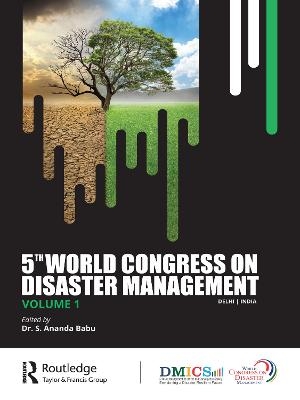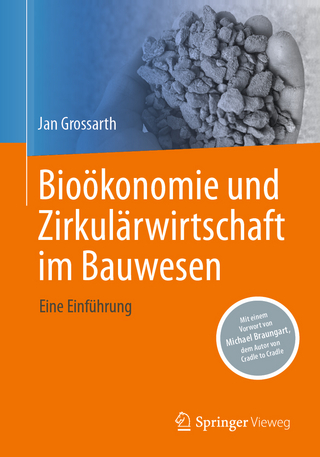
5th World Congress on Disaster Management: Volume I
Routledge (Verlag)
978-1-032-35542-9 (ISBN)
S. Ananda Babu is President of DMICS, Convenor of WCDM.
List of Figures
List of Tables
Preface
Acknowledgement
Part 1: Harnessing Science and Technology for Building Resilience to Disasters
1. "Information Technology": The Utopian Solution to Achieving Disaster Resilience & Ensuring
Disaster Management
Col. Gaurav Bhatia, Arundhati Bhatia, Ranju Bhatia and Abhimanyu Bhatia
2. Female Frontline Health Workers’ and ICT in the COVID-19 Response in India
Krishnan Sneha and Purwar Deepshikha
3. Co-creating Climate Resilience Technological Solutions for Poor
Siraz Hirani
4. Exploring the Potential of Solar Energy in Disaster Management and Rescue Operations
Pooja Punetha, Sukriti Sharma and Asad H. Sahir
5. Harnessing Technology for Disaster Risk Management
Usman, A. Kibon, Bulus, A. Sawa and Ibrahim M. Bako
6. Technological Advances in the Development of Disaster Response Management Systems and Applications
Amritanjali and Geetanjali Kumari
7. Reaching Beyond Low Hanging Apelles to Technological Convergence to Combat Disasters
Like Desertification
Kavya Kamepalli
8. Technological Preparedness for Fire Disasters
K. C. Wadhwa
Part 2: Innovations in Construction Technology
9. A New Fire Safe Design Solution for Reinforced Concrete Beams at Catastrophic Fire Conditions
Banti A. Gedam
10. Seismic Evaluation of Frictional Damper Developed Using Waste Rubber Tires
Bharati, Amit Goyal and R. Siva Chidambram
11. Flexural Behaviour of Masonry Wall Strengthened with Waste PET Grid
Dinesh Chandra Pandey, Amit Goyal and R. Siva Chidambram
12. Numerical Approximation of 3D Heat Conduction in Early Age Mass Concrete Using Crank
Nicholson Implicit Finite Difference Method
Ugwuanyi Donald Chidiebere and Okafor Fidelis Onyebuchi
13. A Study on the Economic Perspective of Utilizing Liquid Tanks as Dynamic Vibration Absorbers in
Building Structures
Tanmoy Konar and Aparna (Dey) Ghosh
14. Smart Shelters for Multi Disasters—A Framework with Cloud Technology and Measurement Devices
K. Sasikala, P. Harikrishna, S. Thamarai Selvi and N. Lakshmanan
15. A Critical Analysis of Building Codes of Pakistan; Fire Safety Provision 2016
Ahmed Faraz Khan and Ijaz Ahmad
Part 3: Using Artificial Intelligence and Internet of Things for Managing Risks of Disasters
16. IoT Enabled Manufacturing and Health Care Services: Potentialities and Prospects in India
Ashok G. Matani and Shamal. K. Doifode
17. Disasters—A New Setback to be Prepared vis-à-vis Artificial Intelligence
Nikhil Kaushal and Prerna Prajapati
18. Application of Artificial Intelligence for Managing Risks of Disasters
Akanksha Jain and Mudit Saxena
19. Scalable IOT solutions with the Amazon Echo Flex Model for 3P integrations
Anil Kumar Bheemaiah
20. Harnessing Technology for Disaster Risk Management: Internet of Things Applications Towards
Mapping of Technologies in Areas of Diagnostics, Testing, Healthcare Delivery Solutions and
Equipment Supplies: Challenges and Opportunities in India
Ashok G. Matani
21. Latest Advancements in IoT and Sensors Applications in Renewable Energy Systems Optimization
Ashok G. Matani
Part 4: Application of Remote Sensing, GIS, Drone and UAV for Disaster Risk Management
22. GIS, Remote Sensing and Drones for Disaster Risk Management
Venkata Rajgopala Gunturu
23. Integrating Weather Model & Remote Sensing Indices for Wheat Yield Prediction in Haryana, India
Manjeet, Anurag, Ram Niwas, Rajeev, Dinesh Tomar, Ram Niwas and S. K. Bansal
24. Floods, Sandbar Dynamics, and its Impact on Communities: GIS Based Case Studies from
Assam, India
Pulak Das
25. GIS Based Hazard Mapping and Vulnerability Assessment of Natural Hazards: A Case Study of
Rudraprayag, Uttarakhand
Vaibhav Pundir
26. Preparedness and Damage Assessment using UAVs for Management of Flood in India
Rudrashis Majumder, Shuvrangshu Jana, Prathyush P. Menon, Debasish Ghose, N. M. Prusty,
Bipasha Mukherjee and Aditi Ghosh
27. Cyclone Preparedness, Rescue Operations and Damage Assessment using UAVs
Rudrashis Majumder, Shuvrangshu Jana, Prathyush P. Menon, Debasish Ghose, N. M. Prusty,
Bipasha Mukherjee and Aditi Ghosh
Part 5: Application of Remote Sensing, GIS, Drone and UAV for Disaster Risk Management
28. Analysis of Compensatory Citizen Services from the Disaster Management Institutional Set Up in India
Devashish De
29. Assessment for Efficient Achievement of Disaster Resilience in India
Gargaei M. Chakravarthy
30. Multi-player Game-based Algorithm Using Set Partitioning for Resource Allocation During
Natural Disaster Response
Rudrashis Majumder and Debasish Ghose
31. Comparing priorities of Providers and Users with Respect to Disaster Management Strategies
Rajat Agrawal and Div Jyot Singh
32. Law and Disaster Management: A Critical Understanding
Awekta Verma
33. Governance of Disaster Management: Lessons Learnt and a Roadmap to Avert a
Future Chamoli Like Disaster
Gopal Vasudeo Wamane
34. Disaster Risks and Management In India: A Critical Analysis of the Disaster Management Act
Akash Kumar Patel and Divya Jain
35. Democratizing Disaster Risk Reduction: A Local Governance Approach to Contextual Knowledge
Production for Flood Planning in Kuttanad, India
Kaniska Singh, Fathima Nidha, Rohit Joseph and N. C. Narayanan
36. Sustainable Operation & Maintenance (O&M) of Multi-purpose Disaster Shelters (MPDS) in Bangladesh
Mohammad Shariful Islam, Samira Tasnim Progga and Tahsin Reza Hossain
37. Disaster Management in India: A Systematic Approach
Sunil Kumar Chaudhary
Part 6: Risk Governance in the Age of Pandemics
38. Existing Resilience Framework for Disaster Risk Management in India
Manish Sharma, Nand Kumar and Ashwani Kumar
39. System Dynamics Approach for COVID-19 Disaster Management
Anjali Saraswat and Satish Pipralia
40. Global Pandemic: Need for a Legal Framework
N. Nabila Hoque
41. Governance for COVID-19 in Bangladesh
Nasim Banu
42. Atmanirbharta—The Journey from Disaster to Human Resilience
Falguni Garg and Lakhan Dhameja
43. Development of Decision Support System for Effective COVID-19 Management
Shuvrangshu Jana, Rudrashis Majumder, Aashay Bhise, Nobin Paul, Stuti Garg and
Debasish Ghose
44. Disaster Management Law in the Context of Covid 19
Priya A Sondhi
45. Accelerating Action on SFDRR Targets D, E and G and Related SDGs in this Decade of
Implementation
Aloysius Rego
| Erscheinungsdatum | 30.06.2022 |
|---|---|
| Reihe/Serie | Fifth World Congress on Disaster Management |
| Zusatzinfo | 63 Tables, black and white; 222 Line drawings, black and white; 222 Illustrations, black and white |
| Verlagsort | London |
| Sprache | englisch |
| Maße | 210 x 280 mm |
| Gewicht | 1580 g |
| Themenwelt | Naturwissenschaften ► Biologie ► Ökologie / Naturschutz |
| Naturwissenschaften ► Geowissenschaften ► Geografie / Kartografie | |
| Technik ► Umwelttechnik / Biotechnologie | |
| ISBN-10 | 1-032-35542-5 / 1032355425 |
| ISBN-13 | 978-1-032-35542-9 / 9781032355429 |
| Zustand | Neuware |
| Haben Sie eine Frage zum Produkt? |
aus dem Bereich


